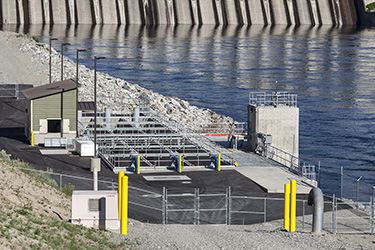|
Subscribe / Renew |
|
|
Contact Us |
|
| ► Subscribe to our Free Weekly Newsletter | |
| home | Welcome, sign in or click here to subscribe. | login |
Architecture & Engineering
| |
 |
January 27, 2014
National finalist: Gold award
Environmental
Tetra Tech
Project: Chief Joseph Hatchery
Client: Colville Confederated Tribes
The Colville Confederated Tribes’ history follows strong traditions surrounding the harvest and sharing of salmon along the Columbia River, which once saw the return of 16 million salmon a year.
Today, 2 million salmon returning to the Columbia is considered a big return year. In the near future, Tetra Tech’s Chief Joseph Hatchery project could add 2.9 million a year to the salmon run, a leap forward in restoring salmon runs of the past.
The Chief Joseph Hatchery fulfills a promise made over 60 years ago to the Colville Confederated Tribes. An agreement reached in 2008 resolved divisiveness surrounding the salmon recovery efforts in the Columbia Basin. The new hatchery also meets technical criteria set forth by the Hatchery Scientific Research Group to protect wild chinook populations.
One of the challenging aspects of the project was the re-engineering of an unused irrigation port that was constructed in 1955. The opening to the irrigation chamber was blocked by riprap, so a new inlet hole was made 10 feet above the original. New strengthening beams were required around the cored inlet, and all underwater steel elements were brought up to the equivalent of a new-construction service life.
To accommodate 2.9 million salmon, Tetra Tech designed acclimation and rearing ponds, which will allow the fish to voluntarily swim to the open river. The ponds combat freezing with automatic groundwater pumps, allowing operators to feed and monitor the fish.
Ensuring essential water quality and quantity for the hatchery at full production required development of a new groundwater source as well as the gravity reservoir source. A two-mile, 36-inch-diameter pipeline delivers up to 35 cubic feet per second of water, with a drop of 200 feet from the highest point to the headbox.
The Chief Joseph Hatchery is a major accomplishment, measured by a decade of commitment from the project team to go from a promise and bare ground to a large-scale modern hatchery while addressing numerous technical and political challenges along the way. The project demonstrates how hatcheries can wisely apply technology in support of nature to restore and enhance the salmon, the foundation of Colville tribal history.
Other Stories:
- National finalist: Platinum award
- Best in State: Gold award
Originality/innovation - Best in State: Gold award
Owner/client needs - Best in State: Gold award
Future value to engineering profession - Best in State: Gold award
Complexity - National finalist: Gold award
Structural systems - National finalist: Gold award
Energy - National finalist: Gold award
Structural systems - National finalist: Gold award
Special projects - Best in State: Gold award
Social/economic sustainability



